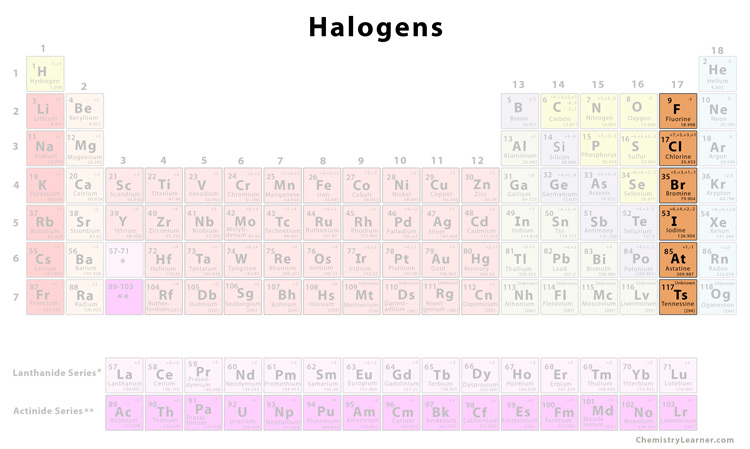Halogens
Definition: What are halogens?
Halogens are special category of highly reactive, non-metal elements which fall in group VIIa of the periodic table. Because of their high reactivity, the halogen family do not exist in nature in their native form, i.e. in monoatomic form. Rather, two atoms of similar element combine together to form stable diatomic molecules.
Where are the halogens located on the periodic table?
Halogens are located on the right and found in group VIIa (new IUPAC) or group 17 (CAS) of the periodic table.
List of Halogens [2] |
|
| Element Name | Symbol |
| Fluorine | F |
| Chlorine | Cl |
| Bromine | Br |
| Iodine | I |
| Astatine | At |
| Tennessine | Ts |
Common Properties and Characteristics of Halogens
Halogens have physical and chemical properties which are typical of non-metal. A noticeable fact about halogens is that their properties like boiling temperature, melting temperature, colour intensity, density, and the radius of the corresponding halide ion increase as we go down the periodic table. On the other hand, there is a decrease in the first ionization energy and electronegativity of these elements as we go down [1].
Physical Properties [2]
- Halogens can be gaseous, liquid, or solid at room temperature depending on their ionization energies and transition temperatures.
- Colour of a particular halogen can also differ depending upon the ionization energies.
- At room temperature, the halogens can display all three states of matter.
- Halogens have nasty smell, are highly toxic and poor conductor of heat and electricity.
Table 2: Physical Properties of Halogens [1]
| Property | F | Cl | Br | I |
| Colour and state at STP | Pale yellow gas | Greenish yellow gas | Reddish brown liquid | Dark violet solid |
| Density of liquid at various temperatures (°C) | 1.51 (-188.15) | 1.66 (-70.15) | 3.19 (-0.15) | 3.16 (-119.85) |
| Melting point (°C) | -219.57 | -101.55 | -16.35 | -113.7 |
| Boiling point (°C) | -188.14 | -33.97 | 58.78 | 184.35 |
Chemical Properties [1, 3]
- Halogens are diatomic, which means that two atoms of halogens combine to form a stable molecule.
- Halogens have seven valence electrons with valency of 1 and hence, are electronegative.
- Halogens are highly reactive and react strongly with alkali metals.
- For example, sodium (Na) combines with chlorine (Cl) to form sodium chloride (NaCl), which is common salt.
- Halogens (X) react with hydrogen (H) to form H-X bonds.
- Length of H-X bond increases as we go down the periodic table.
Applications of Halogens
1. Halogen Lamp
Halogens have a wide range of applications and are most commonly used in incandescent light bulbs in which a current is sent through a tungsten filament in the presence of iodine or bromine gas [4]. These energy efficient light bulbs are common in most homes and offices. Together with a supporting stand, they can be used in floor lamps and desk lamps. They are used in vehicles as headlights and in stadiums as flood lights. Halogens can also be used in under cabinet lighting, as spotlight and as ceiling light..
2. Halogen Heater
Halogen space heaters are energy efficient devices which can generate instant heat over a small area. They are safe to use as they do not overheat while providing desired amount of heat.
3. Halogen Oven [5]
The heating nature of halogen lamps can be utilized in ovens. Such types of ovens are called halogen ovens or halogen cooking pots. These ovens are controlled by a thermostat and food is heated by electromagnetic waves emitted by the lamps.
- References
- Characteristics of Halogens – Chem.libretexts.org
- Physical Properties of Halogens – Byjus.com
- Chemical Properties of Halogens – Chemistryexplained.com,
- Halogen Lamps – Wikipedia.org
- Halogen Oven – Wikipedia.org
- Halogen vs. LED – Ledhut.co.uk, Chemed.chem.purdue.edu
- Halogen vs. Xenon – Chem.libretexts.org
